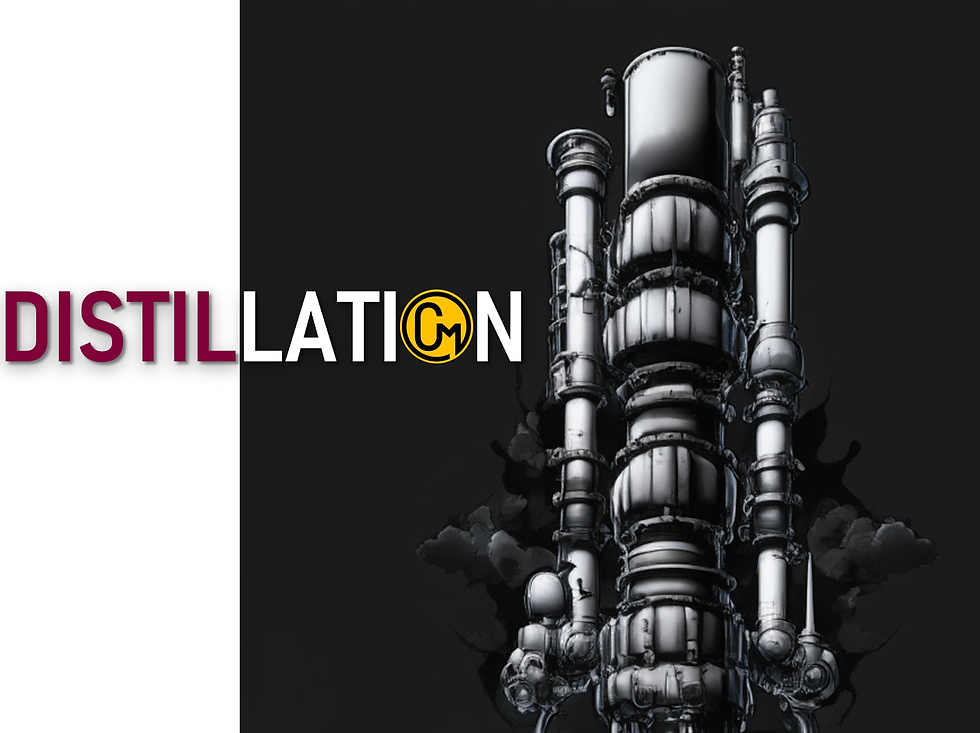Backtrapping: The Silent Killer of Distillation Columns
- Chemojo

- Jun 26, 2023
- 3 min read
Distillation columns are used to separate mixtures of liquids into their component parts. But what happens when something goes wrong? What if liquid from a higher tray in the column starts to flow back down to a lower tray? This phenomenon is called backtrapping, and it can have a number of negative effects on the column's efficiency.
In this blog post, we'll take a closer look at backtrapping, including what it is, why it happens, and how to prevent it. We'll also discuss the effects of backtrapping on the column's separation efficiency, pressure drop, and corrosion.
So if you're an operator of a distillation column, or if you're just interested in learning more about this important process, then read on!

What is Backtrapping?
Backtrapping is when liquid from a higher tray in a distillation column flows back down to a lower tray. This can happen for a number of reasons, including low gas velocity, high liquid load, and improper tray design.
Low gas velocity: The gas velocity is the speed at which the vapor phase flows through the column. If the gas velocity is too low, it will not be able to carry the liquid all the way to the top of the column. This is because the liquid will have more time to coalesce and form droplets, which will be more likely to backflow down to lower trays.
High liquid load: The liquid load is the amount of liquid that is flowing through the column. If the liquid load is too high, it can also cause backtrapping. This is because the liquid will not be able to drain off the trays quickly enough, and it will start to backflow down to lower trays.
Improper tray design: The tray design can also affect the likelihood of backtrapping. For example, if the tray spacing is too close, it can create a "dead zone" where liquid can pool and backflow. Additionally, if the tray design does not provide adequate vapor-liquid contact, it can also increase the likelihood of backtrapping.
Effects of Backtrapping
Backtrapping can have a number of negative effects on a distillation column, including:
Reduced separation efficiency: Backtrapping can carry heavier components back up the column, which can reduce the separation efficiency. This is because the heavier components will be more likely to backflow down to lower trays, where they will not be able to be separated from the lighter components.
Increased pressure drop: Backtrapping can increase the pressure drop across the column, which can reduce the capacity of the column. This is because the backflowing liquid will create additional resistance to the flow of vapor through the column.
Corrosion: Backtrapped liquid can contain impurities that can cause corrosion of the column internals. This is because the impurities in the backtrapped liquid can react with the metal surfaces of the column, causing them to corrode.
Preventing Backtrapping
There are a number of ways to prevent backtrapping in distillation columns, including:
Optimizing the gas velocity: The gas velocity should be high enough to carry the liquid all the way to the top of the column. This can be done by adjusting the reboiler temperature or the feed flow rate.
Controlling the liquid load: The liquid load on the trays should be kept within the design limits of the column. This can be done by adjusting the reflux ratio or the feed flow rate.
Proper tray design: The trays should be designed to minimize the potential for backtrapping. This can be done by using a tray spacing that is not too close and by providing adequate vapor-liquid contact.
Conclusion
Backtrapping is a phenomenon that can occur in distillation columns and can have a number of negative effects. By taking steps to prevent backtrapping, operators can improve the efficiency and operability of their distillation columns.
I hope you found this blog post informative. Let me know if you have any other questions.
To know in details about the distillation, then check out this blog. Click on the image !
Thankyou!
#EngineeringInnovations #BuildingTheFuture #STEMMatters #EngineeringExcellence #ProblemSolvers #InspiringInnovation #TechGenius #EngineeringLife #EngineeringPride #MakersAndCreators #IngeniousMinds #EngineeringPassion #Engineering #Engineers #Chemicalengineers #Chemicalengineering #Processengineers #Chemicaltechnology











Comments